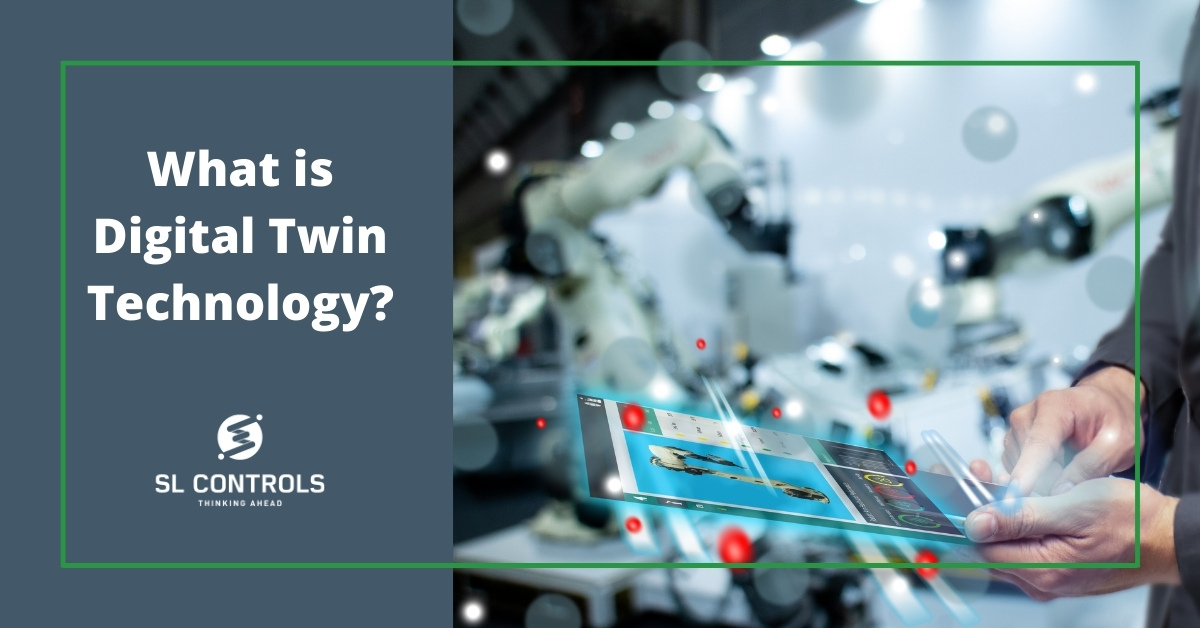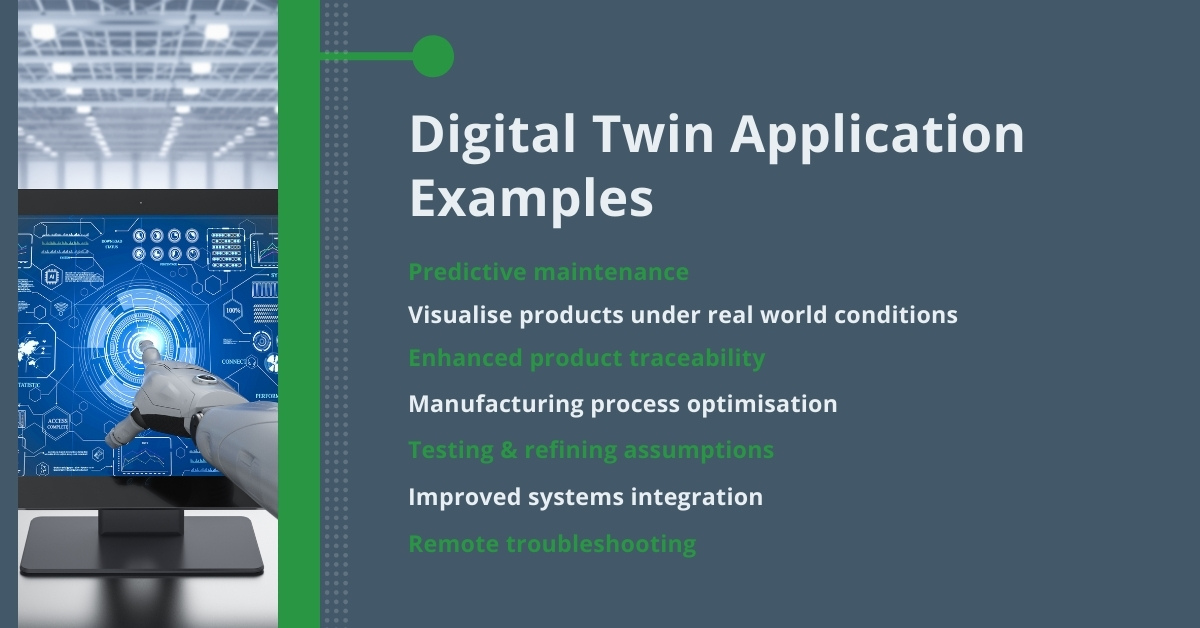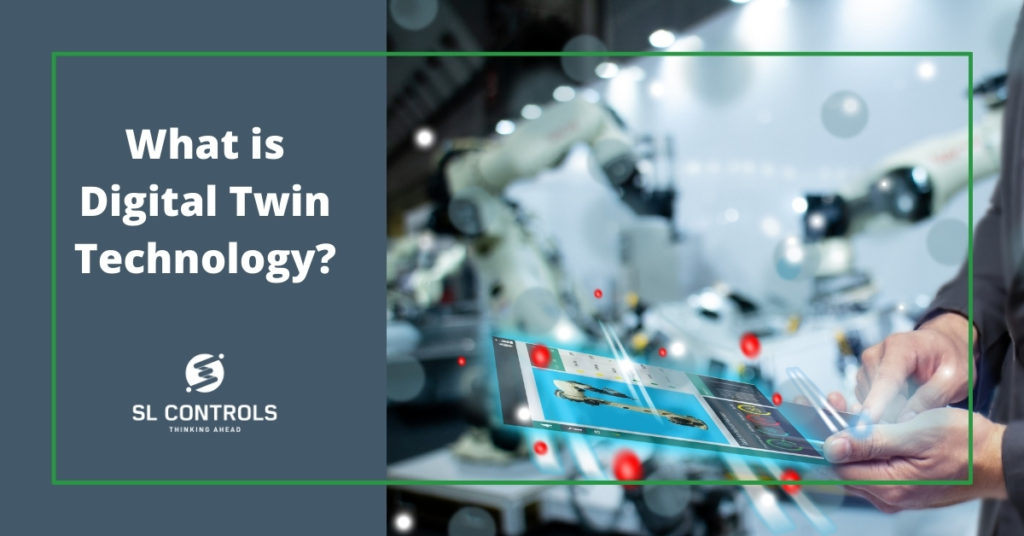Understanding what is happening now on your production line, and predicting what will happen in the future, is essential for maximising OEE, optimising productivity, and improving business profitability. You can achieve all these things with digital twin technologies.
Digital twin technology is one of the most important Industry 4.0 technologies currently available. Digital twins give you insights into all aspects of your production line and manufacturing process.
You can then use these insights to make better decisions, plus you can automate the decision-making process with the dynamic recalibration of equipment, production lines, processes, and systems.
In other words, digital twins provide engineers with virtual tools that allow them to look at, explore, and assess physical assets, processes, and systems. With this ability, it is possible to get an accurate view of what is happening now, as well as what will happen in the future.
What Is Digital Twin Technology?

A digital twin uses virtual and augmented reality as well as 3D graphic and data modelling to build a virtual model of a process, system, service, product, or other physical object. This digital twin is an exact replica of the physical world. Its exact replica status is maintained through real-time updates.
It is a technology that is applicable to a wide range of environments, including the monitoring of products while they are in use and through the entire product life cycle.
In manufacturing, you can use a digital twin technology at various levels:
- Component level – focused on a single, highly critical component within the manufacturing process.
- Asset level – creating a digital twin of a single piece of equipment within a production line.
- System level – using a digital twin to monitor and improve an entire production line.
- Process level – this looks at the entire manufacturing process from product and process design and development, to manufacturing and production. It also applies to distribution and the use of the finished product by customers/patients throughout the entire life cycle, as well as for the development of future products.
So, A Digital Twin is a Simulation?
Not exactly. A digital twin starts as a simulation, but the difference between a digital simulation and a digital twin is real-time updates.
With a simulation, engineers can run tests and conduct assessments on a simulated version of a physical asset. The simulation is static, however. In other words, it doesn’t keep pace with the physical asset unless the engineer inputs new parameters into the simulation.
A digital twin, on the other hand, receives real-time updates from the physical asset, process, or system. Therefore, the tests, assessments, and analysis work conducted by engineers are based on real-world conditions. As the state of the digital twin dynamically changes as it receives new data from the physical world, it matures, producing outputs that are more accurate and valuable.
How Does Digital Twin Technology Work?
A digital twin comprises three main elements:
- Past data – historical performance data of individual machines, overall processes, and specific systems.
- Present data – real-time data from equipment sensors, outputs from manufacturing platforms and systems, and outputs from systems throughout the distribution chain. It can also include outputs from systems in other business units, including customer service and purchasing.
- Future data – machine learning as well as inputs from engineers.
Applications for Digital Twins
Some examples of typical applications for digital twins include:
- Using predictive maintenance to maintain equipment, production lines, and facilities
- Getting a better understanding of products by monitoring them in real-time as they are used by real customers or end-users
- Manufacturing process optimisation
- Enhancing product traceability processes
- Testing, validating, and refining assumptions
- Increasing the level of integration between unconnected systems
- Remote troubleshooting of equipment, regardless of geographical location

What Engineers and Manufacturers Can Do With Digital Twins
First, a digital twin lets you monitor a manufacturing component, asset, system, or process in real-time. This enhanced monitoring capability gives a deeper understanding of what is happening on your production lines and in the wider manufacturing process.
With machine learning and inputs from expert engineers, you can also use the digital twin to identify problems before they occur and predict future outcomes. These predictions include outcomes within existing parameters as well as outcomes if those parameters change.
Digital twin technology supports other Industry 4.0 technologies, too, helping to improve OEE, reduce waste, improve batch changeover times, improve product quality, enhance traceability, and more. It allows for efficient design and development, linking three-dimensional models with simulation and equipment control code emulation.
In addition, having a digital twin enables virtual troubleshooting and support, removing the physical restraints of expert engineers having to be at your location. The technology can also form the basis of customer interactive dynamic supply chains.
Remember, the above includes just some of the things you can achieve using digital twin technologies. There are also manufacturing process development advantages, product development advantages, distribution chain efficiency advantages, and more.
The Benefits of Digital Twin Technology
The benefits that digital twin technologies offer your business include:
- Increased reliability of equipment and production lines
- Improved OEE through reduced downtime and improved performance
- Improved productivity
- Reduced risk in various areas, including product availability, marketplace reputation, and more
- Lower maintenance costs by predicting maintenance issues before breakdowns occur
- Faster production times
- New business opportunities such as mass customisation, mixed manufacturing, small-batch manufacturing, and more
- Improved customer service as customers can remotely configure customised products
- Improved product quality and enhanced insight into the performance of your products in multiple real-time applications and environments
- More efficient supply and delivery chains
- Improved profits
Where to Next?
Digital twin technologies are available now and can bring the above benefits to your business in the short-term as well as the medium and long-term. Plus, the use of digital twins is a growing trend.
To remain competitive, the time to start analysing and implementing this new and potentially disruptive technology is now.





